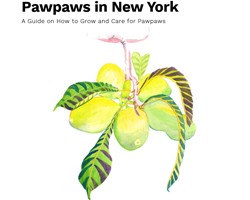Pawpaws in NY: A Guide on How to Grow and Care for Pawpaws
Anya Stansell, WNY Small Fruit Specialist
Harvest New York

The pawpaw (Asimina triloba) is a fruiting tree native to the eastern United States, growing from the Florida lowlands up to the Southern Tier in New York. It is believed that the pawpaw's range is as large as it is because Indigenous Peoples cultivated this tree. Pawpaws have great value as a food crop. They contain 7 of the 9 essential amino acids and are an excellent source of iron and manganese.
Pawpaws used to be a widespread food crop throughout eastern and midwestern states. They were eaten by many during the Great Depression (1929 - 1939). At this time pawpaws gained the nickname "poor man's banana". Pawpaws became less popular in the 1950's, as grocery stores became the place where most people purchased food. Produce buyers for grocery stores showed preference for crops that could withstand shipping over large distances. Marketing by large corporations, such as Chiquita Bananas, made other fruits more popular.
The pawpaw patch in Lansing has attracted much interest due to the large, flavorful fruits and strong trees that grow there. Pawpaw trees grow up to about 35 feet tall. Pawpaws need around 5 to 6 years to begin growing fruits and flowers. Their maroon-colored flowers open between March and May, and fruit become ripe from August through October. Compared to pawpaws that grow in the wild in the Midwest, some of the fruits of the Lansing pawpaws can be 2 - 5 times larger.
Pawpaws in New York: A Guide on How to Grow and Care for Pawpaws, written by Anya Osatuke, Berry Specialist with CCE Harvest NY, Sean Dembrosky of Edible Acres in Trumansburg, NY, and Marvin Pritts of Cornell University, shares practical information on how to grow and care for pawpaws, based on conversations with growers and researchers in New York State and the information provided by the references cited.
Pawpaws in NY: A Guide on How to Grow and Care for Pawpaws (pdf; 1021KB)
Upcoming Events
Whole Farm Climate Adaptation and Mitigation Planning (CAMP) Series
January 13 - February 12, 2026
Jan 13, Jan 29: 10:00 AM - 4:00 PM; Feb 12: 1:00 - 4:00 PM
Kingston, NY
Join CCE Ulster and CCE Harvest New York for a three-part workshop series focused on building climate resilience on your farm. We will cover climate change adaptation and mitigation strategies, learn how to access relevant historical climate data, and begin a climate adaptation plan for your farm!January 13 (Tues): 10:00 AM - 4:00 PM
January 29 (Thurs): 10:00 AM - 4:00 PM
February 12 (Thurs): 1:00 PM - 4:00 PM
